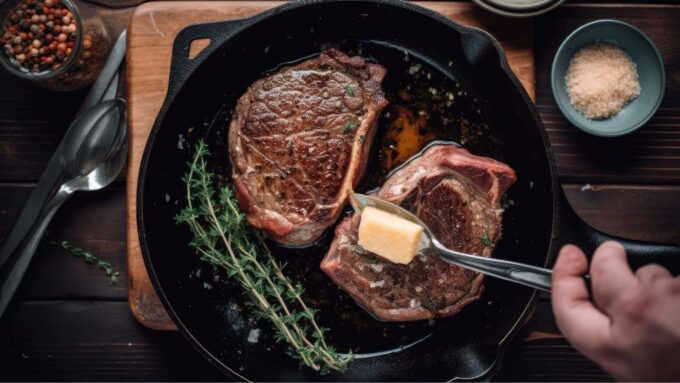
Whether you like your steak rare, medium, or well-done, everyone is after the same thing: a perfectly browned outside with a tender, velvety inside. The overall goal is to lock in as much moisture as possible while cooking the steak evenly. Searing the outside of your steak so that it gets nice and crisp keeps moisture locked into the muscle fibers. However, if you use the wrong cooking fat, you can end up with a burnt steak. To help you achieve steak perfection, let’s take a look at whether you should cook with butter or oil.
It’s All About the Smoke Point
Smoke point refers to the temperature at which your cooking fat will begin to smoke and burn. Ideally, you want your cooking fat to have a high smoke point, as you should be searing your steak over relatively high heat. If you use cooking oil with too low of a smoke point, the oil will burn too quickly, charring the outside of the steak and giving it a burnt flavor. Here are some of the most common cooking fats and their smoke points:
- Butter: 300° F
- Clarified butter: 450° F
- Avocado oil: 520° F
- Rice bran oil: 490° F
- Sunflower oil: 440° F
Cooking With Butter vs. Oil
As you can see, regular butter has a very low smoke point. This is due to its milk solids, which burn easily. When it comes to cooking steak with oil or butter, oil is the clear winner here—to the dismay of many butter lovers. The good news is, this doesn’t mean you can’t infuse your steak with the delicious flavors of butter. Clarified butter, also known as ghee, has a high smoke point, and it still smells and tastes like butter.
However, if you’re set on using regular butter, milk solids, and all, you can try basting your steak in butter. Just toss in a few pads of butter while the pan is still hot, let them melt, and spoon the butter over the steak so that it can absorb all the flavor. This way, you still get the taste of butter without using it as your cooking fat.
What About Olive Oil?
Using olive oil to cook steak remains a point of debate. Olive oil adds a lot of flavor and has quite a few health benefits and what’s better than taking some of the guilt out of eating steak? The problem is that most olive oils have a low smoke point, and even high-quality olive oils only reach a smoke point of up to 410°F, which is barely high enough. Additionally, while some people take the flavor of olive oil as a plus, others find it too overpowering. Unless you really like the taste of olive oil and have access to a high-quality brand, this isn’t the best choice for cooking fat.
Choosing the Right Cooking Fat
When you’re trying to choose the right fat for cooking restaurant-quality steaks at home, you don’t want to pay attention only to the smoke point—you also want to pay attention to flavor. For example, coconut oil has a smoke point of 450° F, but it has a very distinct flavor. To get all the benefits of a high-smoke-point cooking fat without disturbing the flavor profile of your steak, use neutral oils such as soybean, avocado, or safflower oil. Otherwise, high-quality steak doesn’t need much seasoning to taste good. All you really need is some salt, pepper, and aromatics (rosemary, thyme, or oregano) to get the perfect flavor profile.